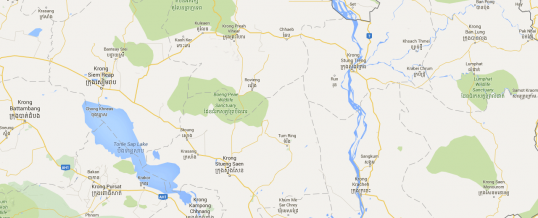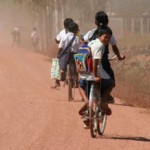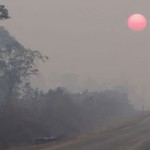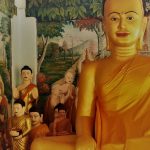
I was looking forward to our trip to Mondulkiri. I had heard a lot about the forests, the waterfalls and the wildlife – even the thrill of possibly meeting a tiger! We were heading for Sen Monorom, known as the final frontier before the wilderness of forest and rivers stretching beyond the eastern border with Vietnam and the border with Ratanakiri Province to the north. It was in Sen Monorom that we would stock up with supplies for the ranger camp and the final bits and pieces we would need to carry in our own packs.
Ranger training and use of cutting-edge technology in the fight against illegal hunters and loggers
Arriving at Sen Monorom at dusk after a bone-jarring ride along dirt roads we checked in to Nature Lodge, a rustic but charming camp just outside town and after dinner were briefed on our itinerary for the next day. We would start with the market then head towards the first ranger post to meet the patrol team and listen to an introduction to the work of the forest rangers, followed by a tour of the outpost where international conservation organization WWF were working in partnership with the government of Cambodia to protect the Srepok Wilderness and adjacent wildlife sanctuaries. Some of the activities involved ranger training and use of cutting-edge technology in the fight against illegal hunters and loggers who raid the forest and sell the meat and timber through an illicit network of traders. All of us were excited about our adventure into the forest as we had been told about a special approach WWF were using to identify tigers and leopard in the forest. No details, this was to be a surprise.
As jobs go, there really aren’t that many to be found in this neck of the woods so the partnership between the government and WWF has created jobs for rangers, trackers and camp staff in this remote and poor area of Cambodia. With improvement in protected area management it is hoped that ecotourism can also bring much needed economic benefits this way and with this in mind WWF in cooperation with local communities has developed some accommodation for travellers along the route through the protected area. Our journey would take us past the venue en-route to our chalets on the bank of the Srepok River, but first a visit to the ranger post.
Although this part of the country has a cooler climate we soon felt the same overwhelming heat we had experienced on our arrival in Cambodia. By 11am we had arrived at the first ranger post and stepping out of the vehicle felt like stepping into an oven. I didn’t want to complain. In front of the station were 2 motos and 3 rangers in olive green uniform ready with a warm welcome. They offered us a drink and the shade of the verandah where we perched on some wooden benches and tried to adjust. Next to the wooden structure lay a pile of timber, enormous logs confiscated from the back of a truck a few days earlier. The rangers showed us other items they had seized such as chain saws and hand tools, not to mention piles of wire snares. It all seemed so unreal. This is the Asian problem you heard about on news reports back home, we knew it went on but to come face-to-face with the irrefutable proof left a daunting impression. The rangers gave us a mini tour of their post, translated for the most part by our guide. Maps pinned to rough boarding gave us some idea of the sheer size of the forest. With less than 30 rangers even we could do the math – patrols are thinly spread. It was all beginning to feel a little too somber and I was glad when our tour leader changed the subject and asked the rangers how they felt about the new technology. It appeared that the science of conservation management was something to shout about indeed and there was a good deal of excitement about how the rangers were learning to use ‘tech’ to patrol more effectively. After a while I left the chatter of the ranger post and went to scout around outside; monkeys were moving high up in the trees and in the undergrowth I could hear birds rustling and when a breeze picked up stirring up the scent of the forest, I began to feel like I had arrived, the forest was starting to draw me in and suddenly I was impatient to get to our destination to begin our forest adventure up close and personal.
Signs of animal droppings the scent of grass
Bumpety, bumpety, bump, up and down the dry channels and through the thick sand of a single lane track with 2 hours ahead of us. So far we had spent most of our time in Cambodia on the road, I was becoming impatient to arrive. Our destination was Mereuk, a ranger station and camp on the Srepok River. About half way there a river crossing provided us with a bit of excitement. Our 4 wheel drive vehicles would easily pass through the river but the drop down the bank looked far too steep to attempt. Our experienced driver engaged low gear and with my eyes shut we dropped over the edge and nudged forward at a snail’s pace at an angle to the river until we eased in and across we went only to face the reverse sheer climb on the opposite side. Finally, with a lot of revving and nudging forward we tipped over the lip and with low gear disengaged proceeded to camp. Phew!
The signs that the landscape was changing became apparent as the forest thinned out and grassy open areas with small water pans became more frequent. We saw signs of animal droppings and felt the wind pick up and wash the scent of grass through the car windows, so this was how real fresh air smelled – exhilarating. It was late afternoon when we pulled up at Mereuk camp and the sun cast a golden glow over the grass and around the little group of people who had come out to welcome us. As we unfurled our bodies out of the position we had been cramped in for a few hours and adjusted to the new surroundings, the peace, space and colours of this new land, our hosts shyly approached and began a chatty repartee with our tour leader, offering traditional greetings; with banter and rising spirits we were introduced and welcomed with wide smiles.
The soft light held clouds of midges floating over the river
The description of the holiday advertised on the website was a true representation of the reality. The raised wooden chalets overlooking the river looked as enchanting as they had in the brochure. Stepping inside we were not surprised to find basic fixtures and furnishings most made from local materials and beds covered by mosquito nets. We knew what we were in for and so were very pleasantly surprised by the little touches we hadn’t expected that someone had thoughtfully considered. Meuruk is remote and transporting anything here is costly and time consuming, I was happy to keep it simple. From our verandah we had a world-class view. The Srepok River flowing steadily by and on the opposite bank monkeys shaking about the trees, birds calling from every direction and the soft light held clouds of midges floating over the river. Dusk fell and we headed down the wooden ladder, slipped on our flip-flops and with torches in our pockets strolled down the narrow sandy path towards the dining area.
Simple wooden furniture under a wooden roof on posts; our dining room had real charm. 360 degree views of nature and when the paraffin lamps were lit the atmosphere was complete. We had already met some of the Meuruk staff and now we met the catering staff, local ladies and relatives of the rangers who had come over to stay while we were here. They chopped and chopped at garlic, chili, and onions and then expertly blended all together to produce a meal of fish, fresh from the Srepok, forest green vegetables and rice, very simple but amazingly tasty. Coffee was always available; the ground coffee came from Vietnam and was made palatable for my taste by the addition of tinned condensed milk, sweet and creamy.
A glance into local living situations which seemed so precarious
The highlight of my trip came the next day when we met the children. The cooks had brought along their little ones and we spent the next morning before breakfast playing and counting to 10 and singing the ABC song in English. I was glad the tour organizers had made some thoughtful suggestions of items we might like to bring along to share. I had brought a colouring book with forest animals and together we learned the English word and the Khmer word with lots of giggles at our garbled attempts. In the same way we had brought along some bits and pieces suggested by our company to leave for the ladies who worked in the camp to show our appreciation, again in a simple way trying to be mindful of the disparity between us and avoid any uncomfortable or offensive gestures.
Some tour operators don’t feel the need to mention to their guests how their impact effects the lives of the people where they visit; I suppose most visitors think that the proceeds from their visit go to pay the staff that serve them, plain and simple. However, as my travels so often gave me a glance into local living situations which seemed so precarious, I realized that the needs of people living in the places I visit are many and varied and that said, thought there were surely other ways that I could make a contribution. With this in mind I set out to research and found that there are a growing number of tour operators who are already responding to this trend and suggest several ways their customers can contribute/participate in activities designed to improve social welfare and other aspects of people’s lives in foreign destinations.
Earlier in the tour we had been promised a ‘surprise’ and we still had no idea of the form it would take. Our timetable said we were to meet at the dining area and come prepared for a forest walk. So, dressed in lightweight long pants, hiking boots, a lightweight shirt with long sleeves, a hat and a traditional Khmer cloth scarf from Sen Monorom market, we waited in suspense for the day’s agenda. After a brief safety induction and a checklist of what and what not to do we set off behind our guide in single file. We followed a narrow path away from the river and soon broke out into the grassy clearings we had seen on the first day. Our guide pointed out small tracks in the sand and explained how the birds and small mammals searched for seeds and insects in the undergrowth. It was fascinating stuff but we were urged on as we had an appointment to keep further into the forest, the mystery deepened and we hurried along to keep up.
The challenge was to try and take in as much of the forest as possible but keep my eye on the track for possible hazards, in places trees towered above us and gazing up to the light I was entranced by the patterns of interlacing leaves, each one competing for precious light. I thought I was taking in all there was to see but when our guide stopped to show us the scratch marks on the bark of a tree made by a sun bear, I realized there was far more to the forest than immediately apparent and without the expert knowledge of our guide we would have missed an awful lot, when we stopped I pulled out my guidebook to the mammals of South East Asia to compare the tracks and signs. A while later a flurry of feathers caught our attention and between the trees we watched a peafowl, a large brightly coloured bird similar to a peacock screech a warning of our presence. I would have liked to reference a bird book but to save weight I had left it behind. I thought about the app on my phone, which would have been easy to use except for the lack of a data signal deep in the forest. Luckily one of the group had brought a book along and we were able to find the small tracks in the sand but even through we searched for a jewel coloured feather there was none to be found.
Can you tell the difference between the poo of a tiger and the poo of a leopard?
We plodded on down into a dry riverbed where a bamboo grove cast a deep shade over the only remaining pool of water, this was tiger territory. Tigers are rarely seen these days; in fact in recent years only their tracks have been captured on camera. Still, we didn’t take any chances and approached with caution hoping to find some evidence of a tiger’s recent visit. Disappointed this time we nevertheless had a spring in our stride as we were getting close to the meeting place where a ‘surprise ‘ awaited. I don’t know what I expected, maybe an elephant-back patrol, or a refreshing waterfall but I was rather puzzled to see a lady with a labrador, as if I were in an English park! This however was no ordinary lab’ but a specially trained ‘Conservation Canine’ a dog who smelled out scat, who could tell the difference between the poo of a tiger and the poo of a leopard and who had been hired by WWF to assist with a species monitoring program.
The dog, ‘Scooby’ was not a pet; strictly a working dog and we weren’t allowed to make a fuss. Scooby, and handler were taking a break during the heat of the day when the scent is harder to detect. We learned that conservation assistance dogs are carefully selected and trained to scent out all manner of scat in species such as bears, whales, the big cats and others. They work very closely with their handler and have a strict routine, which includes attention to their training. Scooby and handler had traveled to Cambodia all the way from the United States and were mid-way through their task, to range across selected transects of the forest in a grid pattern and although there had been no evidence of tiger so far they had successfully gathered and identified leopard scat. Everyone agreed that this was a pretty remarkable canine and I made a note to take a look at the Conservation Canine web page when I returned.
After a short break our trek headed in the direction of the river and we crossed a network of gullies leading down into the Srepok, twisting through finely filtered sunlight in the bamboo glades, keeping our eyes peeled for any sign or sound of a tiger. Our guide mentioned that during the rainy season we wouldn’t be able to enter this section of the forest on foot which meant the patrols had to travel on the back of an elephant. However flooded conditions meant a drop in the incidence of poaching throughout the forest leaving the wildlife in peace. Finally we saw the river glinting up ahead between the trees and waiting for us was the camp ranger in a boat ready to take us home. After the day’s long walk it was very pleasant to sit in the boat and feel the rush of fresh cool air lift away the heat and stickiness of the trek. The lowering sun caught edge of the ripples on the water and the light sparkled in the boat’s spray as it splashed either side and coated us with fine drops, the boat headed upstream towards a spot where we hoped to see otters. The oriental small-clawed otter was another species seldom sighted possibly due to human interference but here in the river a family had been spotted. We stopped the boat a short distance away and quietly waited. On the bank we could see evidence of their presence, paw prints in the mud. After a while a sleek grey head popped out of the water on the other side of the bank, then disappeared and reappeared bobbing up and down and finally vanishing silently under the over-hanging vegetation.
Tasty and as natural as it gets – nature truly provides rich fare in the forest
Our final evening meal in the Srepok wilderness was, unsurprisingly – fish and rice but this time with a lime/lemongrass flavour. Mixed with pepper the meal was lean, tasty and as natural as it gets; nature truly provides rich fare in the forest. Sitting around the small campfire we shared our thoughts on our forest experience. Some of us felt that we could easily stay another day; I would have liked to learn more about the botanical aspect of the forest. One species in particular fascinated me, bamboo. We tend to have a single idea of the image of bamboo usually accompanied by a chewing panda but here in the dense forests of SE Asia there are many species. Needless to say, there is an array of uses for the bamboo, local people use every part of the plant and these days we can find bamboo in clothing such as t-shirts and socks. Overall, I think my fascination is one linked to sense of place, the forest’s dappled light filtering through the towering shady groves, small zephyrs rustling the leaves the only sound and the sense of danger, hidden from view but oh so close, the tiger’s lair.
Our final stop on the road leading from Mondulkiri into Ratankiri was close to the village of Lumphat. The Srepok River wound around the edge of the Lumphat Wildlife Sanctuary and we were going to take a look at the fishing along the river. Our guide educated us on the traditional fishing methods and the problems experienced in these parts, such as competition for fishing territory. The Mondolkiri Protected Area Management Programme included management of fisheries, as the river was part of the reserve. PA management worked closely with the villages to establish fishing practices that would help to conserve the biodiversity of the riverine ecosystem. The community project officers held eco-education workshops in key villages to raise awareness of fishing practices that have a damaging influence and to discuss how the communities can work together towards a fisheries management plan.
This was all very educational but most of us wanted to have a go, to try to catch a fish. Fortunately a couple of the fishermen from the village were obliging and fashioned rods from bamboo cut from the riverside then added a bit of line and hook. Firstly, we were drilled in the technique of casting before adding a bit of bait. Everyone was keen and there was a spirit of competition in the air. We spread out up and down the bank, scrambling for the best spots between clusters of flesh-scraping bamboo. Needless to say, there wasn’t a bite, we had made too much noise and fuss and alas, the fish had fled. While non-too successful with the fishing I am pleased to say my ‘birding’ went well. Some of the new additions to my lifetime bird list included: the changeable hawk eagle, a silver pheasant, an Indian roller and the majestic green peafowl. Some were familiar friends: the common hoopoe, a jungle fowl and the call of the coucal-or rainbird, hoop-hooping deep in the undergrowth. It was the wrong time of year for water birds, at their best during the rains, the spectacle of black storks, wooly-necked storks, giant ibises and the sarus cranes are of special interest. However, attempting to visit the Mondulkiri Forest in the rainy season is a ‘camel adventure’ style challenge, the only way in is on the back of an elephant! Sadly our journey through Mondulkiri had come to an end but I knew I would be back, I had spotted an opportunity for high adventure in those forests and I was itching to put together a new trip, mountain biking!
- Travels in Cambodia – Three days in Mondulkiri - 15 June 2015
You might also like these articles
JUN
2015



